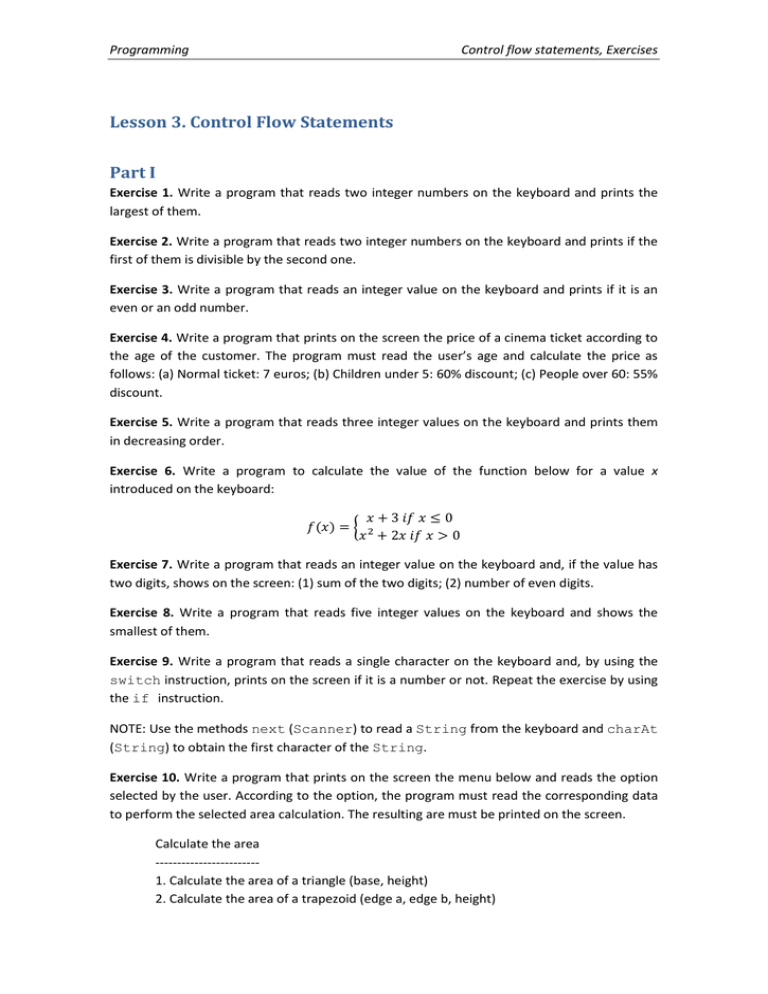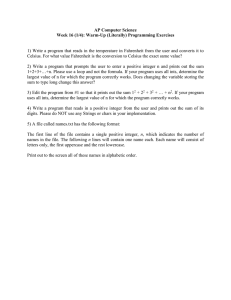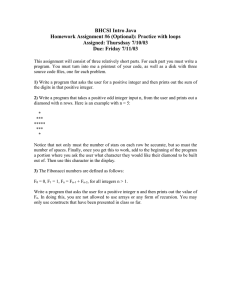Lesson 3. Control Flow Statements Part I
advertisement

Programming
Control flow statements, Exercises
Lesson 3. Control Flow Statements
Part I
Exercise 1. Write a program that reads two integer numbers on the keyboard and prints the
largest of them.
Exercise 2. Write a program that reads two integer numbers on the keyboard and prints if the
first of them is divisible by the second one.
Exercise 3. Write a program that reads an integer value on the keyboard and prints if it is an
even or an odd number.
Exercise 4. Write a program that prints on the screen the price of a cinema ticket according to
the age of the customer. The program must read the user’s age and calculate the price as
follows: (a) Normal ticket: 7 euros; (b) Children under 5: 60% discount; (c) People over 60: 55%
discount.
Exercise 5. Write a program that reads three integer values on the keyboard and prints them
in decreasing order.
Exercise 6. Write a program to calculate the value of the function below for a value x
introduced on the keyboard:
( )
{
Exercise 7. Write a program that reads an integer value on the keyboard and, if the value has
two digits, shows on the screen: (1) sum of the two digits; (2) number of even digits.
Exercise 8. Write a program that reads five integer values on the keyboard and shows the
smallest of them.
Exercise 9. Write a program that reads a single character on the keyboard and, by using the
switch instruction, prints on the screen if it is a number or not. Repeat the exercise by using
the if instruction.
NOTE: Use the methods next (Scanner) to read a String from the keyboard and charAt
(String) to obtain the first character of the String.
Exercise 10. Write a program that prints on the screen the menu below and reads the option
selected by the user. According to the option, the program must read the corresponding data
to perform the selected area calculation. The resulting are must be printed on the screen.
Calculate the area
-----------------------1. Calculate the area of a triangle (base, height)
2. Calculate the area of a trapezoid (edge a, edge b, height)
Programming
Control flow statements, Exercises
3. Calculate the area of a rectangle (base, height)
4. Exit the program
Part II
Exercise 1.
Write a program to print the integer numbers from 1 to 100.
Write a program to print the integer numbers from 1 to 100 counting two by two.
Write a program to print the integer numbers from 100 to 1.
Exercise 2. Write a program to print the multiples of 3 from 1 to 100.
Exercise 3. Write a program to print the series: 5, 10, 15, 20, 25, 30… The program must read
on the keyboard the number of terms of the series to print.
Exercise 4.
Write a program to read 10 positive numbers on the keyboard and print the following values:
1. Addition of the numbers
2. Arithmetic mean of the numbers
3. Largest number
4. Smaller number
Exercise 5. Repeat exercise 4, but reading the values from the keyboard until the user
introduces a 0 –i.e., the number of values is not fixed.
Exercise 6. Write a program to read an integer number, calculate its factorial, and print the
result on the screen.
NOTE: The factorial of an integer n is the product of the integer values from 0 to n:
n! = 1 * 2 * 3 * … * (n-1) * n
Exercise 7. Write a program to read an integer value on the keyboard and print an asterisk
square of this size. For instance, if the number is 4, the program must print:
****
****
****
****
Exercise 8. Repeat Exercise 7, but only printing the border of the asterisk square. For instance,
if the number is 4, the program must print:
****
* *
* *
****
Exercise 9. Write a program to read the amount and prices of various products and calculate
the final price of the shopping cart.
Programming
Control flow statements, Exercises
The program must ask the user:
Enter number of products:
The user must enter a positive integer value. If the value is negative, the question must be
repeated until the user introduces a positive integer value.
Next, the program must ask the user:
Enter value of the product:
This number must be also a positive integer. If the value is negative, the question must be
repeated until the user introduces a positive integer value.
Introducing values for the shopping cart is finished when a 0 is introduced as the answer of the
first question. Next, the program must print the total price of the cart. (The total price is the
result of the sum of the prices of each line of the shopping cart; the price of a line is the result
of the multiplication of the product price and the product amount.)
Exercise 10. Write a program to create an array of integer values and assign to each position of
the array the position value plus 1. The number of elements of the array must be read on the
keyboard.
Exercise 11. Write a program to initialize and print a two-dimension array with random double
values in [0, 10). The size of the array (size and columns) must be read from the keyboard.
Exercise 12. Extend the program of Exercise 11 to calculate:
The maximum value of the array
The minimum value of the array
The sum of the elements in the diagonal (i.e., elements at positions (0, 0), (1, 1), etc.)
Exercise 13. Write a program to calculate the addition of two two-dimension arrays. The size
of the arrays (rows and columns) must be read on the keyboard. The values of the arrays must
be randomly initialized. The program must check if the dimensions of the arrays are suitable.
Programming – Grado en Ingeniería Informática
Authors
Of the English version:
Juan Gómez Romero
Based on the work by:
Ángel García Olaya
Manuel Pereira González
Silvia Castro García
Gustavo Fernández-Baillo Cañas
Daniel Pérez Pinillos
Javier Ortiz Laguna
Álvaro Torralba Arias de Reyna
![FLOW OF CONTROL [SET – 2]](http://s2.studylib.net/store/data/017977535_1-c37e1b962aa6eca26276a355420b85b2-300x300.png)

